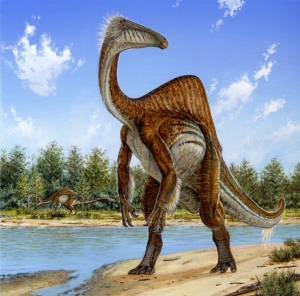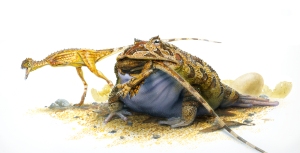Today started out as a fairly normal day. I overslept thanks to marathonning House late into the night/morning (note: not due to working late/early on my publication, oops), I dragged myself out of bed and into the office. I then, still half-asleep checked Twitter (the morning ritual was well underway) and then suddenly, I displayed both ends of the Nedry–Grant excitement chart (patent pending) simultaneously. Deinocheirus. It was Deinocheirus, DEINO-RUDDY-CHEIRUS! At the moment, I’m in an office full of volcanologists, so no-one understood my excitement (in fact most thought I had some form of disposition, I mean I was practically frothing at the mouth with excitement). I immediately texted Richard and all my other palaeontological friends/colleagues with two words: DEINOCHEIRUS PUBLISHED.

My face on the morning of the 22nd October 2014. (I even laughed like a Dilophosaurus).
Story time
So why was I so stupidly excited? Well, I’m glad you asked. To explain this excitement, our tale begins in 1965. It was July, and the Polish-Mongolian Palaeontological Expedition had stumbled upon a ‘monster’ find. Forelimbs and a shoulder girdle 2.4 metres long belonging to a 70 million-year-old dinosaur with surely the largest forearms of a bipedal animal ever. However, that was all they found. What in the Seven Hells was this magnificent beast? Surely these the arms of some superpredator, akin to Allosaurus or perhaps a mega-Velociraptor? Deinocheirus mirificus was (‘unusual horrible hand’) was ‘born’. For seven-years, this was the most likely explanation. In this time, palaeontologists and members of the public alike went wild with fantastical recontructions of this new and wacky beast, some even going as far as noting that the arms were used much like those of a giant sloth. Alas, in 1972 John Ostrom (the guy responsible for revolutionising the way we think about dinosaurs in relation to birds in the 60s) noted that the bones in the forearm of Deinocheirus appeared similar to those found in the ornithomimosaurs, a group of secondarily-herbiverous theropod dinosaurs very similar to modern ostriches. This agreed with the sentiments of the team that initially discovered Deinocheirus, so it was settled, the beast was in fact an ornithomimosaur. Mystery solved. Right?
Unfortunately not. Fast forward a little over 40 years later to October 2013, and we still hadn’t found any more remains of the all-too mysterious Deinocheirus. That was all to change. At the SVP 2013 Symposium (one of the biggest annual events in palaeontology) there were hushed, exciting whisperings of new Deinocheirus material (apparently, I couldn’t afford to go). And then, a speaker emerged and confirmed it, Deinocheirus was back, the mystery was apparently solved. New material had been discovered and we now had a 95% complete skeleton to work with. However, this wasn’t fully shown at SVP, and the entire palaeontological community had to wait with baited breath until the work was published. One of the greatest mysteries of 20th and 21st century dinosaur palaeontology had been solved, but we had to wait. It was agonising. Personally, I grew up enthralled with the mystery of Deinocheirus as did many palaeontologists, both young and old, so to be kept in the dark like this was painful.
The Big Reveal
Fast forward again, exactly (pretty much) to a year later. Late October 2014. A dreary-eyed, 20-something-year-old palaeo grad-student is almost hyperventilating over an image he found on Twitter. Ladies and gentlemen, Deinocheirus has landed. And bloody hell if it isn’t the weirdest thing we’ve ever seen.
Mystery Solved
Standing almost as tall as T. rex, and weighing in at a hefty 6 tonnes Deinocheirus is the biggest ornithomimosaur to date. So it was big, no biggie right (heh)? Wrong, in addition to it’s monstrous size it’s also (and I might have already said this) bloody weird. With a really deep lower jaw, no teeth, huge forearms, relatively small hindlimbs, a big old “beer belly” (the best description of dinosaur’s anatomy ever, thanks Tom Holtz!) and tall neural spines (similar to those seen in Spinosaurus) Deinocheirus sure is different to the ‘typical’ ornithomimosaurian body plan of Galimimus, with long legs and many other features that suggested it was a fast runner. Quite the opposite, Deinocheirus was a big, sluggish brute with a huge appetite. After 50 years, the mystery of Deinocheirus seems to be solved then, it’s a incredibly odd looking, slow moving, bulky, T. rex sized, beer-bellied behemoth. Myth busted, right?
Again, wrong. These new specimens are that good that we can already begin to hypothesise how Deinocheirus actually lived out it’s seemingly odd, slow lifestyle. Deinocheirus was discovered in the Nemegt Formation, a deposit which is 70 Million years-old (Late Cretaceous), and was an ecosystem similar to that of the Okavango delta today. First off, over 1400 gastroliths were present, probably used to aid in digestion of food, (mainly plants) making up for the lack of teeth. The morphology of it’s jaws and its broad bill (similar to those found in hadrosaurs and ducks) suggest that certain muscles associated with biting were small, meaning that Deinocheirus probably ate soft (and possibly water-dwelling) plants. But there wasn’t just some stones in that big beer belly, no sir! Evidence of a half-eaten fish was found as well, indicating that Deinocheirus was no means a fussy eater, and probably a ‘megaomnivore’ eating pretty much anything it could get it could swallow. This seems to fit well, especially when you consider Deinocheirus’ place in the Nemegt ecosystem, as generalist ‘all you can eat’ type deal (finally, a dinosaur I can relate to) it wouldn’t be in such harsh competition with the other herbiverous dinosaurs in the area that mostly ate plant matter from trees. However, not only do you need to outcompete you friendly neighborhood herbivores to keep on truckin’ in a Cretaceous world, you also need to be not eaten yourself. The main threat in the Nemegt ecosystem was probably the 12 metre long, 5 ton tyrannosaur, Tarbosaurus. However, Deinocheirus seemingly has an answer to everything by sacrificing speed for bulk and size, it was probably too big (and bloody hell, those claws) for Tarbosaurus to safely take on.
We also know a few more tricks that Deinocheirus had up its exceedingly large sleeves. Remember those Spinosaurus-like neural spines? They were probably there to support the bulky beer belly, similar to an “asymmetrical cable-stayed bridge“. It also had broadended tip-toes (pedal unguals, to be technical), allowing it not to sink when wading into wetter areas. And those claws? No longer used as lethal disembowlers, but for digging/plant gathering. So Deinocheirus seemingly was perfectly adapted to life on the braided, meandering rivers of the Nemegt ecosystem, unafraid of pesky Tarbosaurus, perfectly content to munch away until its heart (and beer belly) was content, and then waddling to the next patch of river to devour (and P.S Deinocheirus didn’t half walk funny).
And the moral of the story is…
By now, you’ve probably found literally hundreds of grammatical and spelling errors, due to the fact that I’ve been excitedly vomiting words onto my laptop in wave after wave of dino-induced mania. Yes it’s weird, and yes I love it because it’s pretty much me in dinosaur form, but why is this important? You’ll probably see this on IFLS (I F***ing Love Science) in a summary post, with ‘weird fat dinosaur discovered’ alongside ‘cure for cancer found’ and ‘artificial intelligence finally sorted’, making palaeontology, yet again look like the stupid and childish sibling of all the other sciences (e.g. “dino with big nose discovered”, unfortunately not a joke). But this is more than just some crazy guys with beards and stetsons finding a random pile of bones and shouting eureka until Nature finally publishes their work. Oh no. This, as well as many other finds over the last year shows us just how extreme dinosaurs can get. In the past 12 months, we’ve had a new, now with more swimming (TM) Spinosaurus recontruction, Dreadnoughtus, possibly the largest dinosaur ever, as well as long-snouted and pygmy tyrannosaurs. Not to mention feathered ornithischians (R). Dinosaurs have often been regarded as evolutionary extremes, and we’re only now beginning to understand just how these extreme animals lived and evolved.This understanding allows us to further understand evolution works, and how organisms can evolve in various environments and under different conditions.Not only is Deinocheirus a weird and wonderful beast, but when we look at it as a living, breathing animal, rather than a poster-child for all things weird and wonderful, we can begin to further understand the evolutionary processes involved in theropods, a group which would garner the evolution of an incredibly diverse and successful group of animals, the birds. Deinocheirus exemplifies that palaeontologists, by investigating extremely adapted animals, such as dinosaurs, can further the understanding of the the process of evolution, one of the most important processes on Earth, and just how far it can go, and what wonderfully strange creatures it can help to explain.
So there you have it. Deinocheirus. It sure is a good day to be a palaeontologist.












